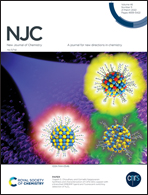A BF3-mediated C–H/C–Li coupling of 1,3,7-triazapyrene with 2-thienyllithium in the design of push–pull fluorophores and chemosensors for nitroaromatics†
Abstract
Mono- and bis-2-thienyl-substituted 1,3,7-triazapyrenes have been synthesized for the first time via BF3-mediated C–H/C–Li coupling of 1,3,7-triazapyrene with 2-thienyllithium in 33 and 51% yields, respectively. The photophysical properties of these polycyclic azaaromatics have been studied, with emission in the range of 450–500 nm and fluorescence quantum yields of up to 99% in methanol solutions being revealed. The turn-off chemosensing properties of 2-thienyl-substituted 1,3,7-triazapyrenes for the selective detection of nitroaromatics have also been assessed; in particular, the quenching constants according to the Stern–Volmer model, the quenching sphere radius according to the Perrin model, the detection limit and the quenching efficiency have been determined. In particular, 6,8-bis-(thiopen-2-yl)-1,3,7-triazapyrene, characterized by 10 times the quenching constant and limit of detection (LOD) compared to the mono-substituted analog, can be considered as the most promising chemosensor for determining nitroaromatic compounds. DFT calculations confirm the presence of intramolecular charge transfer (ICT) effects in the case of the obtained fluorophores and clarify the quenching mechanism for nitroaromatics.



 Please wait while we load your content...
Please wait while we load your content...